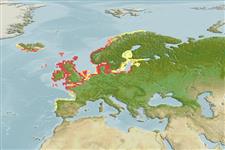Environment: milieu / Klimaatzone / Diepte / distribution range
Ecologie
marien; brak water demersaal; oceanodroom (Ref. 51243); diepte 6 - 30 m (Ref. 57178). Temperate; 80°N - 37°N, 25°W - 36°E
Northeast Atlantic: Murman and Spitzbergen to Portugal, including Iceland and much of the Baltic.
Lengte bij maturiteit / Grootte / Gewicht / Leeftijd
Maturiteit: Lm 13.0, range 11 - 15 cm
Max length : 40.0 cm SL mannelijk / geslacht onbekend; (Ref. 4674); common length : 20.0 cm TL mannelijk / geslacht onbekend; (Ref. 4645)
Tip of pectoral fin reaches the front end of the dorsal fin. Dark spot on each side of the snout. Two pointed teeth in the palate. Upper jaw not protractile (Ref. 35388).
Body shape (shape guide): elongated.
Inshore, including the inter-tidal zone and estuaries, and offshore to about 60 m depth. Commonly associated with Ammodytes species. Feeds initially on zooplankton, later small fish (clupeids and ammodytids) dominate the diet. Summer batch spawner. Used mainly for fishmeal and oil, but also utilized fresh and pan-fried for human consumption (Ref. 9988).
Muus, B.J. and P. Dahlström, 1974. Collins guide to the sea fishes of Britain and North-Western Europe. Collins, London, UK. 244 p. (Ref. 173)
Status op de Rode Lijst van het IUCN (Ref. 130435: Version 2025-1)
Gevaar voor de mens
Harmless
Gebruik door de mens
Visserij: van groot commercieel belang; aas: occasionally
Tools
Speciale rapporten
Download XML
Internetbronnen
Estimates based on models
Preferred temperature (Ref.
123201): 8.8 - 12.8, mean 10.3 °C (based on 476 cells).
Fylogenetische diversiteitsindex (Ref.
82804): PD
50 = 0.7500 [Uniqueness, from 0.5 = low to 2.0 = high].
Bayesian length-weight: a=0.00324 (0.00174 - 0.00601), b=3.00 (2.84 - 3.16), in cm total length, based on LWR estimates for this species & (Sub)family-body (Ref.
93245).
Trofisch niveau (Ref.
69278): 4.0 ±0.1 se; based on diet studies.
Generation time: 2.7 ( na - na) years. Estimated as median ln(3)/K based on 1
growth studies.
Weerstandsvermogen (Ref.
120179): Gemiddeld, minimale populatieverdubbelingstijd 1,4-4,4 jaar (tm=2; Fec=35,000).
Fishing Vulnerability (Ref.
59153): Low to moderate vulnerability (32 of 100).
🛈
Nutrients (Ref.
124155): Calcium = 50.7 [28.6, 103.2] mg/100g; Iron = 0.402 [0.237, 0.669] mg/100g; Protein = 18.9 [17.2, 20.8] %; Omega3 = 0.405 [0.217, 0.718] g/100g; Selenium = 10.1 [4.9, 20.7] μg/100g; VitaminA = 20.1 [7.0, 60.0] μg/100g; Zinc = 0.594 [0.420, 0.824] mg/100g (wet weight);
